There doesn’t seem to be much information on how to prepare for the Cambridge B2 First speaking test. Some readers have been quite successful in getting high scores in this test using the following advice. If you are studying for the Cambridge Advanced C1 Speaking test, there is a similar, but slightly different post here.
- 1. Watch Official Preparation Videos
- 2. Understand the Test Format
- 3. Familiarize Yourself with the Assessment Criteria
- B2 First Speaking Part 1
- 4. Know Your Background
- 5/ Extend Your Answers
- B2 First Speaking Part 2
- 6. Master Vocabulary Related to People
- 7. Put the Pictures into Your Answer Template
- 8/ Prepare Phrases for Contrasting and Comparing
- 9/ Prepare Speculative Phrases
- B2 First Speaking Part 3
- 10. Take the Initiative
- 11. Use Phrases for Agreeing and Disagreeing
- 12/ Choose the Best Option
- B2 First Speaking Part 4
- 13/ Use Phrases for Giving and Asking for Opinions
- 14. Organize Your Answers
- 15. Clarify When Needed
- 16. Utilize Effective Body Language for B2 First Speaking
- 17. Seek Professional Help
1. Watch Official Preparation Videos
Click here for the examiners’ comments on how Victoria and Edward performed in their B2 First Speaking test.
Click here for the examiners’ comments on how Victoria and Edward performed in their B2 First Speaking test.
Click here for the examiners’ comments on how Natalia and Enzo performed in their B2 First Speaking test.
Click here for the examiners’ comments on how Julia and Isabella performed in their B2 First Speaking test.
Cambridge examiners taking about speaking tests
When you are finished, watch them again, and read the examiner’s comments (downloads on the right-hand side) step by step.
This may seem an obvious way to start your B2 First studies, but many fail to even realise the official videos are there.
2. Understand the Test Format
Memorize the order of the speaking test, so that you know what is coming next and you know what kind of questions / speaking you’ll need to do. The official link is here or read the information below and at the start of each section.
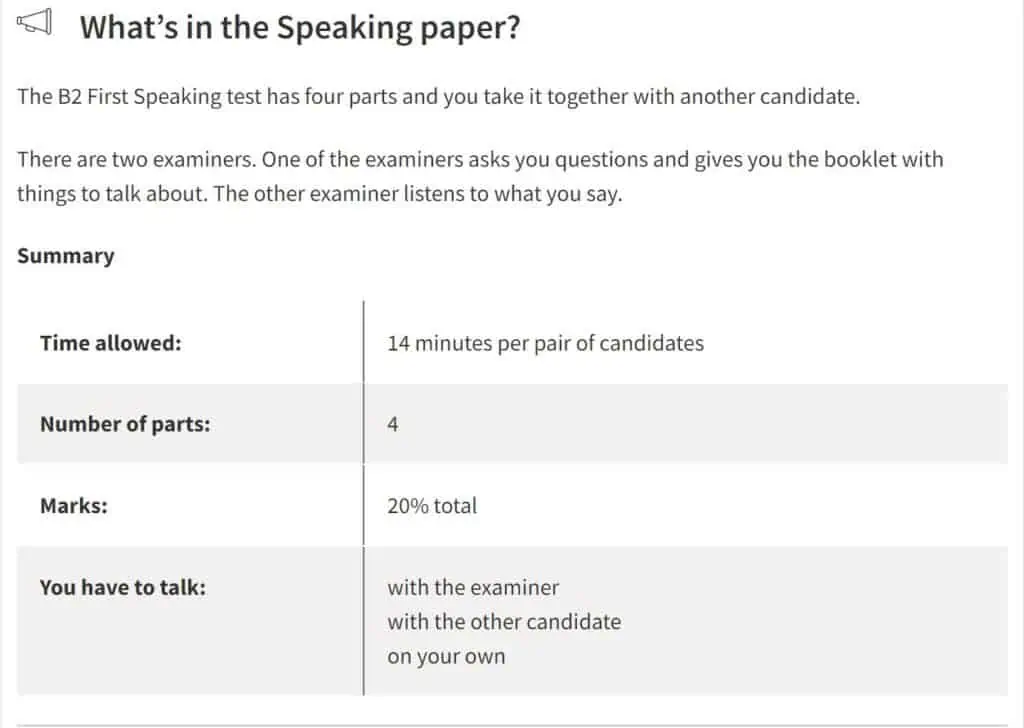
3. Familiarize Yourself with the Assessment Criteria
Be aware of the marking criteria, and practice your weaknesses the official rubric is here, especially on page 2 (below). This file also refers back to the Victoria and Edward test, so you can listen and mark what you think they are doing right and wrong. This is a very useful exercise.

.
.
B2 First Speaking Part 1
.
.
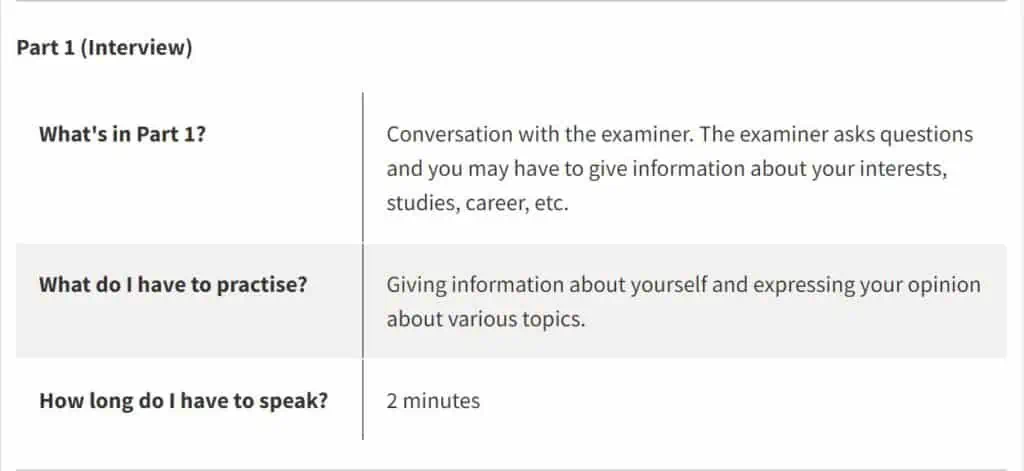
As with all the Cambridge exams, in Part 1, you will be asked questions about yourself, your life and your opinions. You know the answers to these questions, so it’s a good way for you to relax and get comfortable for the rest of the test. Or is it?
This is an ideal time for you to show what you can do with your English because you know the answers to these questions. However, before we get on to that, there’s another thing you need to think about. Who are you?
4. Know Your Background
Know who you are, where you’re from, why you are learning English, and so on. You know the answers to these questions, so you shouldn’t need to hesitate, or repeat yourself. This part is to put you at ease, but also for the examiner to start assessing your level. You know the answers, you know your life, but you need to know how you are going to answer. For example, look at the question below.
Examiner – Where do you come from?
You – I come from eh eh, do you mean the town I live in now or the town I was born in?
You have to decide what you are going to say BEFORE the exam. Do you come from X? Do you come from Y? Or do you want to say: Well, I was born in X, but I have lived in Y for the last 3 years, and I would prefer to say I am from Y. The last one is the better answer, but you do not want to hesitate.
You know the answer to the question, that’s why you’re asked it. If you have to bend the truth a little, that’s fine, it’s an English test, not a memory test.
Examiner – Where do you come from?
You – I come from a lovely little seaside town called Whitby on the east coast of England. It’s really picturesque, but life there is too slow for anyone under 60 years old.
Examiner – What’s your favourite food?
You – Hamburger or pizza, hamburger or pizza……… eh…….eh
Decide what you are going to do. Choose the first thing that comes into your head? Choose the second of a choice of two?
A good way is to do it like this
Examiner – what’s your favourite food?
You – I used to absolutely love HB chocolate biscuits when I was younger, but these days I don’t seem to have such a sweet tooth, so my favourite food is oranges, especially the small ones.
5/ Extend Your Answers
Answer the question and extend your answer, using better vocabulary and/or change the grammar. If you don’t answer the question, you can’t change the grammar tense.
Examiner – Where are you from?
You – Belgium
There is no tense in the answer ‘Belgium’, so you have nothing to change.
Try this
Examiner – Where are you from?
You – I’m from Belgium.
Now you have a tense, but you have no information: so, add something.
Examiner – Where are you from?
You – I’m from a little-known town in the south of Belgium called noname town, It’s a market town for the surrounding farming community, and is quite busy for such a small place.
Better, you have more detail, you’re putting a picture of the place in the examiner’s head, but the grammar is still in the same tense. Try this
Examiner – Where are you from?
You – I’m from a little-known town in the south of Belgium called noname town, I’ve been living there for the last 10 years since I moved there with my family from Antwerp.
So now you’ve changed have an extended answer, better vocabulary, and increased grammar range. All because you know the answer to the question.

.
.
B2 First Speaking Part 2
.
.
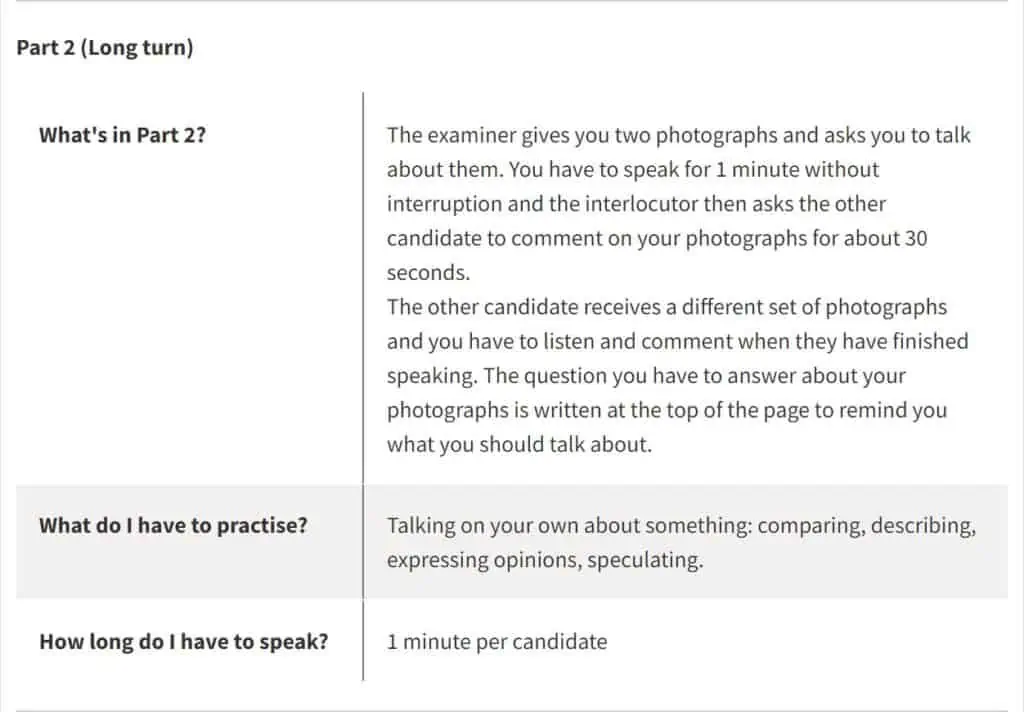
In Part 2, the examiner gives you two pictures, and you have to talk about them for 1 minute without interruption. To do this you should answer the question at the top of the page, compare and contrast the pictures, give your opinion and speculate about aspects that are either unclear or unknown. You need to do all this in one minute. It’s not a long time, so you need to practice. This is how.
6. Master Vocabulary Related to People
Learn Vocabulary About People for the B2 First Speaking Test
Benefits: Using Quizlet allows you to integrate vocabulary learning into your daily routine, enhancing your speaking test performance.
Importance: Mastering vocabulary related to people is essential for the B2 First Speaking test, particularly for tasks involving image comparison and contrast.
Focus Areas:
Occupations: Terms for various jobs and roles
Actions: Words describing activities and behaviors
Social Roles: Terms for different social and familial roles
Recommended Resource:
Quizlet App: Offers vocabulary sets for Cambridge B2 First, C1 Advanced, C2 Proficiency and IELTS
Topics Covered: Professions, physical descriptions, common activities
Flexibility: Practice on mobile or web platforms during commutes or breaks
7. Put the Pictures into Your Answer Template
Use your preparation time to put the pictures into what you have learned in class. What does this mean? Read on, you may also need practice pictures and sample answers.
Who, what, when, where, why, how many, how much, how long, …..
You only have one minute to compare and contrast the pictures, and that isn’t long. It takes a lot of practice to be able to answer the question and compare and contrast using speculative language in such a short time. I have discovered that a kind of ping-pong method, going quickly from one picture to the other and back is much more effective than talking about one picture, then the other.


The question is
Why might it be important to give advice in these situations?
In the first example, I try and go from one picture to the other quite quickly. Like this:
In the first picture, it looks as if there is a mother helping her son with his homework, while in the second picture, it looks as if there is a football coach telling his team how to win a game. In his mother’s eyes, it is important for the boy to study hard, so he passes his exams in my opinion. Saying that the coach may be giving advice on how to win a game in a competition, so the team will progress. Although the mother and the coach are both giving advice, there are only two people in the first photo, whereas, in the second, there are many more. A similarity is that both the son and the football team appear to be under pressure to succeed, but the mother and the coach are calmly working through the problems for the best results. On the other hand, there are still differences such as the team are all wearing football gear, while the mum and the boy are dressed casually. I guess they are at home, but the team seem to be in a changing room at some kind of sports facility.
In the second example below, I talk about one picture, then the other
In the first picture, it looks like there is a mother helping her son with his homework. In the mother’s eyes, it is important for the boy to study hard, so he passes his exams, in my opinion. There are only the two of them in the first picture and they look like they are at home. The boy looks like he is under pressure, but the mother is calmly working through the problem. It looks like they are at home, and they are dressed casually. In the second picture, it looks as if there is a football coach telling his team how to win a game. The coach may be giving advice on how to win a game in a competition, so the team will progress. He is also calm, while the players will be under more pressure to succeed in my opinion. The football team are wearing football gear and seem to be in a changing room at some kind of sports facility.
In the first example, if you hesitate (and you will because you are under pressure in an exam) you can still compare and contrast, and you can still answer the questions using your speculative language.
The problem with the second example isn’t the English, but it gives you fewer chances to use your comparing and contrasting language and it also doesn’t help if you pause to think. You could still be talking about the first picture when your time is over!!!!!
8/ Prepare Phrases for Contrasting and Comparing
For Similarities / Comparing:
- Likewise
- Also
- Similarly
- Equally
- In the same way
- As with
- Like
To Contrast:
- However
- Whereas
- On the other hand
- Conversely
- Alternatively
- Instead of
- Unlike
9/ Prepare Speculative Phrases
Speculative Phrases for Comparing and Contrasting
- They could/might/maybe…
- They could/might/may have just…
- They seem to be…
- I’m pretty sure that they’re feeling…
- I’d guess that they are…
- It looks like they could be… / are at a… / are doing…
- It’s quite hard to tell, but I think they may be…
- Perhaps he’s a…
- He doesn’t look like a…but
- They look like they’re a… family
- It looks like she’s teaching him what to do
- It looks like he’s watching her doing her job
- It’s possible that he’s just missed the train
- I’m pretty sure they’re happy because they’re smiling
- Maybe they’re going on a trip
.
.
B2 First Speaking Part 3
.
.

In Part 3, you and the other student need to discuss the different options of the central theme, described in a mind map or picture. You need to do this for two minutes and show you can pass the discussion back and forth between you and your partner giving your opinions and agreeing and disagreeing.
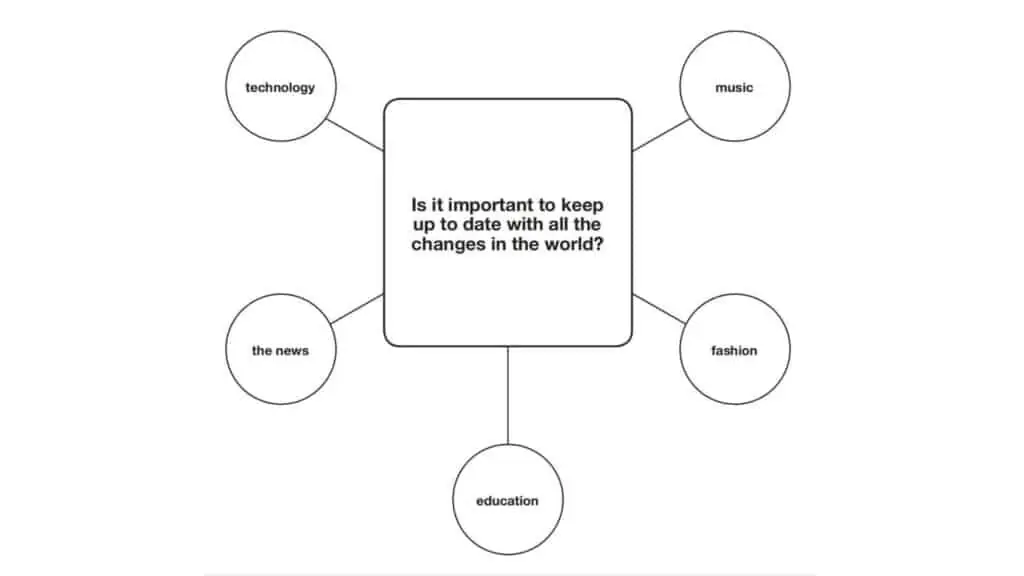
10. Take the Initiative
Practice being proactive and taking the lead, try one of these phrases. This lets you take the lead and talk about what you want to talk about first.
Do you mind if I start/begin?
I’ll start if you like
Shall I start?
11. Use Phrases for Agreeing and Disagreeing
Agreeing:
- I think we see eye to eye on that.
- Yeah, I’d go along with that.
- You’re absolutely right.
- That’s so true.
- Absolutely!
- You took the words right out of my mouth.
- I couldn’t agree more.
- You have a point there.
- I’m with you 100% on this one.
Disagreeing:
- We don’t see eye to eye on that, I’m afraid.
- I take your point but…
- I tend to disagree with you there.
- That’s not always the case.
- I beg to differ.
- Isn’t it more a case of…
- I don’t think so.
- I’m not sure I agree with that.
Agreeing is a more positive experience during the exam, so don’t waste your test arguing about some small point, unless you use great language to do it. Another thing you can do is to use concessions like although, even though, despite, in spite of ……
For example,
- Although I thought [X] when I saw the question, I see your point and now agree with you on that.
- Even though I believed [Y], I now think you’re right.
- Although I’m not 100% convinced, I’ll go along with you for now.
- Despite wanting to believe [Z], I see your point.
- In spite of some personal experience in the matter, I agree with what you are saying.
After you have talked about the mind map for 2 minutes, you then have to decide with your partner, which is the best option. You have 1 minute!
12/ Choose the Best Option
Proposing a Best Option:
- I think we’ve covered all the bases. Which option do you think is the best?
- I think we agree that [option A] and [option B] aren’t the best, don’t we?
- Well, [option C] isn’t really an option, and as for [option D], I’m not too keen on that. What do you think?
- Ok, I see your point. Let’s go for [option E] as the best.
Expressing Your Opinion:
- In my opinion…
- The way I see it is…
- As far as I’m concerned…
- If you ask me…
Asking for Others’ Opinions:
- Why do you think that?
- What makes you say that?
- What do you think?
- Do you agree?
- What are your thoughts on that?
- Would you agree with that?

.
.
B2 First Speaking Part 4
.
.

In Part 4, the two examinees and the examiner have a discussion, asking and giving opinions about different questions. Here are some example questions.
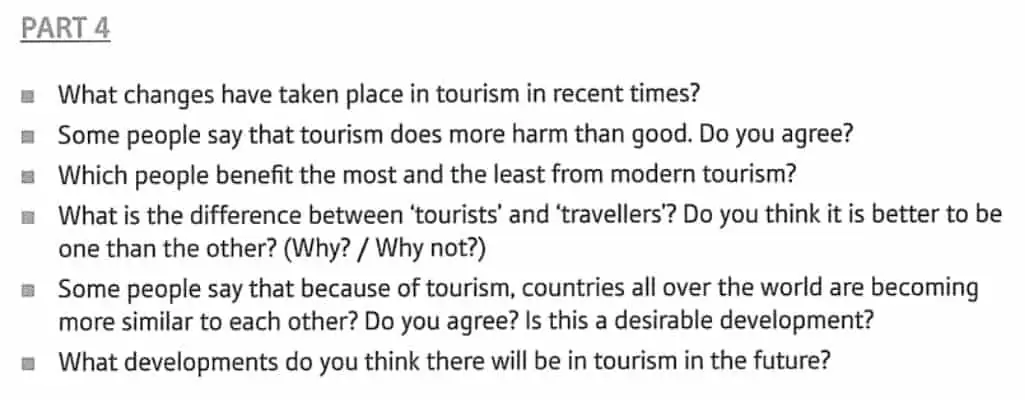
13/ Use Phrases for Giving and Asking for Opinions
Use phrases for giving your opinion and asking the other student and the examiner about theirs.
Check how well you know these phrases with this quick quiz.
14. Organize Your Answers
Use organisation if you can such as discourse markers – there are several reasons why …… Firstly …… secondly ……….. and finally ……… but don’t talk forever. Phrase list n examples of some of them in practice – quiz question with mixed ones to show which are right n which are wrong.
Sequencing
- First, ….. second,……. finally……..….….
- and after that ………
- ….……, and subsequently ……….
Emphasising
- Above all ……In particular
- Especially
- Significantly
- notably
Also, use your speculative phrases, and especially modal verbs to soften any statements that are too strong. Using might, may, could,….. to soften opinion n examples with meaning.
15. Clarify When Needed
Sometimes you just don’t hear the question properly or don’t understand it. Instead of guessing, use your English to ask the examiner to repeat the question. These phrases are the best ones to use, choose one or two to use if you need to.
- I’m sorry, but could you repeat that please?
- I’m afraid I didn’t hear what you said.
- Could you repeat that?
- Could you say that again, please?
- What did you say?
- I beg your pardon.
16. Utilize Effective Body Language for B2 First Speaking
It’s always good to give a good impression in the test, so dress comfortably but smartly, and keep eye contact with the examiner or the other student when you are talking to each other.
Listen actively, so nod your head in agreement, or shake your head in disagreement, and so on. It helps the others and it also helps to keep you engaged in the test.
Use open body language, so don’t sit and fold your arms or cross your legs to make you look defensive.
Also, speak up, this is a speaking test, so the examiner and the other student need to be able to hear what you say. If you don’t speak up, you’ll lose points, and taking the exam will be a waste of time.
17. Seek Professional Help
Taking lessons to improve your performance and improve your score is also very useful, especially if you are studying alone, or are lost in a big class. Olga from Russia used the advice given above and practiced with her friends and an English teacher before her test. She actually got 100% in her speaking test, so these methods work. Here is the picture of her results.
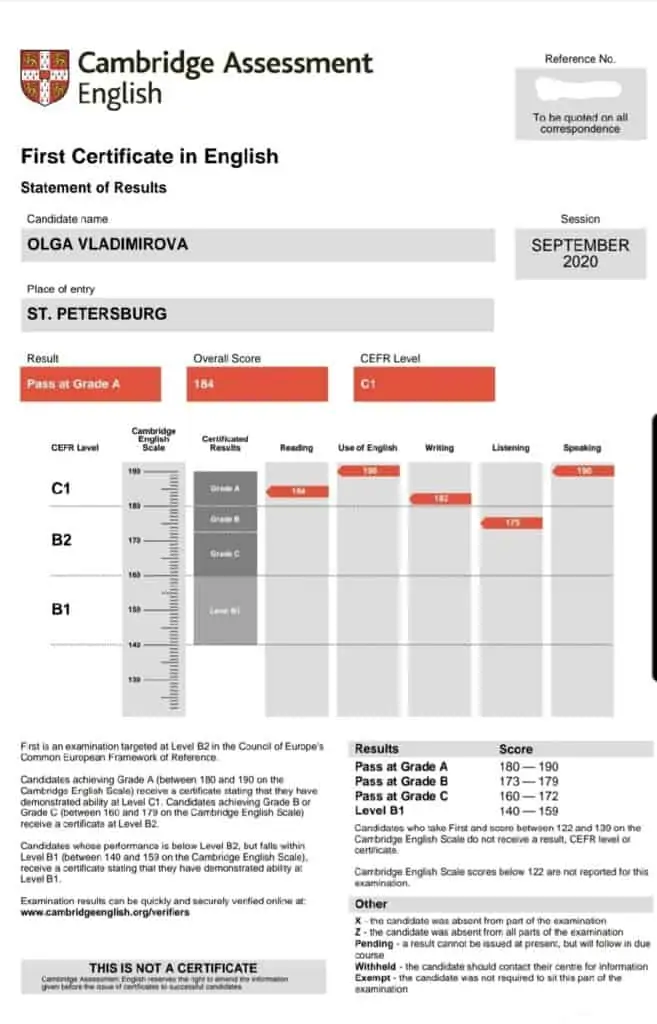
I hope these 17 ways will help you get the best score possible in your B2 First speaking test. Good luck!
